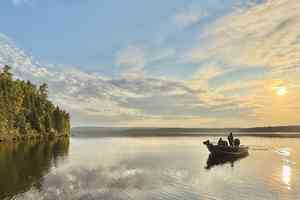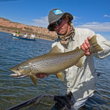I’m sitting with Jack Handey, who has deep thoughts and loves chocolate. We’re perched on the edge of our jet boat which we’ve pulled aground on a mid-stream sandbar of Kamchatka’s Savan River, finishing off our lunches as we marvel about the river’s rainbows. Thirteen days into a 14 day trip down the Savan, we’re still blathering on about its resident trout—not specifically about their size, strength, beauty or numbers, but more about their unique combination of all those qualities. It is the Savan’s rainbows that truly define the river. As with rivers all over Kamchatka, the Savan’s trout are the paintbrush with which the river is painted and so to talk about the Savan one inevitably must talk about its rainbows, which call the river home throughout their lives while the rest of its most prominent inhabitants—all 5 species of Pacific salmon and the odd kunja—are just visiting.
The Savan is located in the southwest of Russia’s Kamchatka peninsula, a short, roughly forty minute-long Cold War helicopter ride from Yelisovo, a small city in Kamchatka’s southeast that functions primarily as a transportation hub for travelers coming in and out of the peninsula’s largest and only significant city, Petropavlovsk, which sits just 20 miles or so to the north.
The river flows for 70 meandering miles before its confluence with the Opala which, in turn, dumps into the Sea of Okhotsk. As it courses, it transforms from a narrow, rocky spring creek that carves its way through a landscape of steep hillsides blanketed with stonecrop and Erman’s birch to a wide, shallow expanse lined by interminable, cloudberry-flecked tundra to a braided, deeply-channeled river of increasing heft and power. Each kilometer of the Savan seems distinct from the one that preceded it and yet the river maintains a unifying character, driven in no small part by its rainbows and its verdant, green and almost overwhelming lushness.
Around a year prior, I sat on the dusty banks of Argentina’s Limay river as my guide, Santos, regaled me with tales of Kamchatka’s greenness. I brushed his account aside, reasoning that Santos had spent most of his years in the arid, canyon-lined reaches of Patagonia’s Neuquen province. I, on the other hand, had grown up on a small farm in humid, rural southern New Jersey spending the better part of my childhood navigating through reams of sticker bushes, busting through endless thickets of honeysuckle and chasing frogs through swamp and marsh, all alive with the wet stink of summer. Maybe Santos didn’t know green, but I surely did. Yet none of those childhood years, or anything I had seen since, prepared me for just how green the Savan was. Every centimeter not covered by water or bare rock is dedicated to photosynthesis, for as far as your eye can gaze.

Jack and I wash down our lunch with pieces of Snickers bar which our guide Anatoli has slivered up neatly with a Mora knife. Cheap, but sharp and hardy Mora knives are so ubiquitous in Russia that it sometimes feels like the guides pull them from behind their ears the way a dime store magician might produce a quarter for an audience of easily duped children. Lunch includes the Russian staples we’ve become accustomed to over the course of a couple of weeks: cut cheeses and meats, fresh cucumbers and tomatoes, black bread and Garcheezya. Lots and lots of Garcheezya, a spicy Russian mustard that brings tears to your eyes each and every time you’re not precise and careful with your portioning.
More Like This
Jack’s agreement with my guess about the Savan and its rainbows—that perhaps nowhere else on the peninsula can an angler find such an ideal combination of size, strength and numbers—is welcome. While I’m clocking my thirteenth day in Kamchatka, Jack long ago clocked his fiftieth. Having already experienced more Kamchatka fisheries than I’m likely to see in my lifetime, Jack’s confirmation meant a lot more than my conjecture.
Some days it seems like there’s a hidden outlet pipe on the Savan that prints 24-inch fish. According to The Fly Shop, who exclusively books the southwestern Kamchatka river, the average rainbow in the Savan is between 22 and 26 inches, with 30 inchers encountered often enough to make them a real possibility on every trip. But tallying the river’s rainbows based on their length alone fails to do them justice. The Savan’s bows are bulky and shouldered and protest with a vigor that’s much more akin to a saltwater fish. Fish that come to hand and get released without marvel are far less common than those inspire slack jaws and bewildered stares.


Jack and I have spent the week exploring the lower Savan in two jet boats, with guides Dima and Anatoli, returning each evening to a minimalist but comfortable lodge that sits mid-river. We’ve swung streamers through riffly rock gardens, clumsily tossed dolly llamas underneath overhanging trees and skated mouse patterns over every bucket—depressions in the river bed caused by spawning salmon creating redds—we could reach. When the Savan’s trout come, the takes and fights are furious.
My morning has been particularly eventful. I’ve snapped my running line in half trying to dislodge my sink tip from under a rock after a fleeing rainbow wedged it there. During the ensuing effort to retrieve my skagit head and tip, I shatter a spey rod in three places when I fail to tend to it as we motor the jetboat close to a tree. Luckily, I’ve stowed away a second two-hander and, as the only angler on the trip with a spey rod on hand, I’m left to myself on what Dima considers to be one of the Savan’s finest stretches of water and one that’s seldom fished by the almost exclusively one-handed clientele: a deep, brawling 100-foot wide riffle that’s almost a rapid and that, I soon learn, is stacked with 25-27 inch rainbows. In the course of about an hour and a half, six of those riffle’s bows come to hand with a handful more hooked and lost. Thanks to the brutish current and brawny fish, each squarely hooked rainbow takes me into backing at least once. My shoulder is aching as Jack and I pull the boat back into the current after lunch is cleaned up.

Prior to our week on the lower Savan, we spent five days floating the upper river, camping each night under the stars in the middle of the most sincere wilderness into which I’ve ever ventured. Brown bears are seen daily. Sometimes three, sometimes 15 or more. Fed, fat and happy thanks to the Savan’s salmon, the bears pay us little mind. They largely ignore us on the river and, though the dogs keep watch for intruders, the bears seem entirely uninterested with the odors that billow from camp each night as our cook, Tanya, prepares borscht, other delicious Russian soups, pastas and more.
Throughout both weeks, whether jetboat or raft, boats are used strictly for transportation. All fishing has been on foot, which is almost always my preference. The boats get us where we need to be, and we’re off to pluck a rainbow from the Savan however we’re able to.

Upriver we fish mice whenever we can and whenever we can typically means whenever we want to. The takes come more often with streamers, as they’re likely to do anywhere, but there may be few things more exhilarating in all of fly fishing than a big rainbow chasing down a mouse. And so we fish mice. A lot. Even when we know we shouldn’t. When we encounter fish sipping dries—which we do, even the occasional chum salmon—we try our luck.
Each encounter with one of the Savan’s rainbows is a trophy in the truest sense. Not the fish, but the encounter itself. Whether a reward for the long journey to Kamchatka or a prize paid for with a willingness to adventure, each catch and release is a moment spent in awe, left only to exhale and look up from the river—something we anglers seldom do—and take stock of the place you’re in.

Some days, the river’s trout are more willing and eager than one could reasonably expect. Other days they are less so. But regardless of their number, encounters with the Savan’s rainbows are always too few. Each day, it seems impossible to leave the river not wanting more. For now, I’ll look to tomorrow and to more of those encounters. But, in the evening, when the helicopter returns from Yelisovo to take us away from here, I’ll start planning my trip back.
IF YOU GO
Choosing an Outfitter
If you want to fish the Savan, thanks to an exclusive agreement with the Russian outfitters that operate on the river, there's only one show in town: The Fly Shop. The Fly Shop pioneered fly fishing on the Kamchatka peninsula when it first opened to the public (after being closed for over 50 years as a Russian military territory) in 1990. Rest assured you'll be in good hands.
When to Go
Fishing season on the Savan begins in July and ends in September.
How to Get There
For years, the only way to get to Kamchatka was to fly virtually around the world through Moscow or take an even more complicated western route through Korea and Mongolia. However, a few years ago, Yakutia Airlines resumed its flights from Anchorage to Yelisovo, making travel to Kamchatka relatively easy.




























Comments